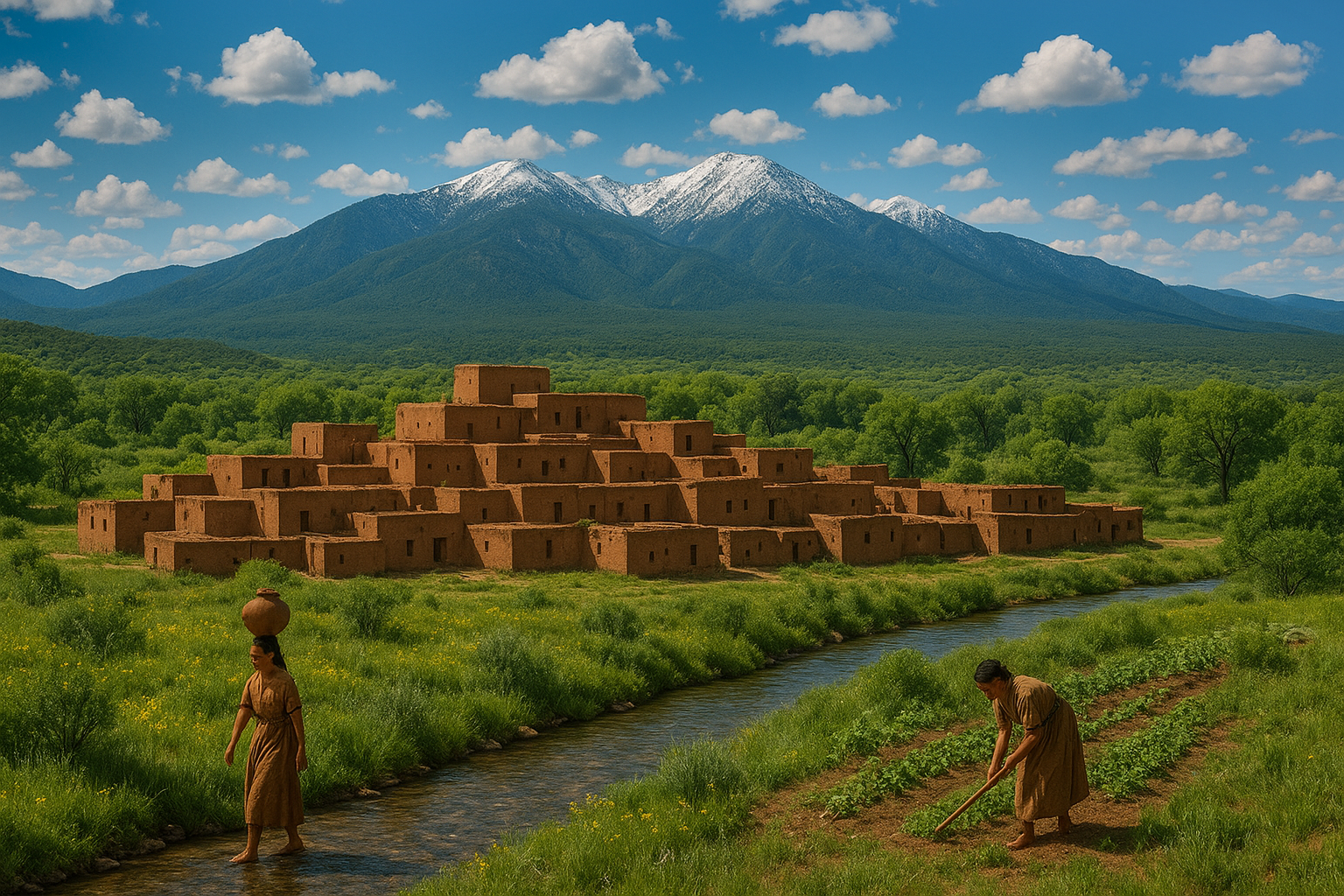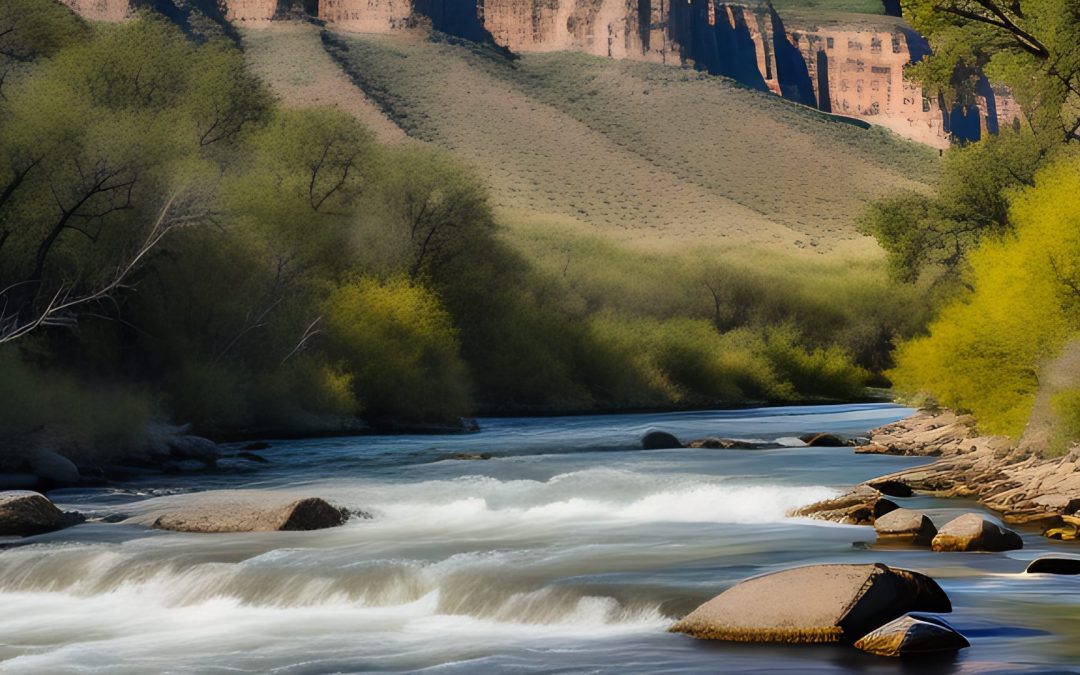When the Spanish first entered the northern Southwest in 1540 under Francisco Vázquez de Coronado, they were astonished to encounter thriving adobe citadel settlements, known today as pueblos. Built of earth and stone, these fortified towns were home to hundreds of families and supported by farming, artistry, and ceremony. For the Spaniards, who expected scattered bands of nomadic hunters, the pueblos were a revelation.
One of the most fascinating of these ancestral sites was Arroyo Hondo Pueblo, located just five miles southeast of Santa Fe, New Mexico. Long abandoned before Coronado arrived, Arroyo Hondo was once a bustling town of more than 1,000 rooms and 10 plazas. Thanks to decades of archaeological research, this pueblo offers one of the clearest windows into the life, resilience, and struggles of the ancestral Puebloan people.
If you’re exploring Santa Fe history, or planning to visit New Mexico’s cultural sites, Arroyo Hondo Pueblo is an essential story to know.
Life in the Northern Rio Grande Valley Before Arroyo Hondo
By the 1200s, the northern Rio Grande Valley was home to dozens of small pueblos, each with 50–100 rooms. Families grew corn, beans, and squash near scarce water sources, hunted deer and rabbit, and gathered wild plants.
The climate was favorable, harvests were steady, and life was relatively peaceful. Because of this stability, these early pueblos were not fortified. Their layouts emphasized community and farming efficiency rather than defense.
But in 1295, everything changed.
The Great Drought and the Need for Fortified Pueblos
Around 1295 CE, the Southwest was struck by a Great Drought. Modern climatologists have confirmed this was part of a global climate event, possibly triggered by the eruption of several massive volcanoes between 1250 and 1300.
The effects were devastating:
-
Farming failed across the San Juan Basin and Mesa Verde areas, leading to total abandonment.
-
In the Rio Grande Valley, starvation and desperation triggered violent raids.
-
Small pueblos, undefended and vulnerable, were attacked and sometimes burned.
In response, families consolidated into larger, fortified pueblos. By combining resources and strength in numbers, they could withstand raids and store food more securely. Out of this upheaval, Arroyo Hondo Pueblo was born.
The First Arroyo Hondo Settlement (1300–1340)
Founding
Around 1300 CE, Arroyo Hondo began as a modest 100-room pueblo near a spring and on the lip of a deep canyon. The location offered both water and natural defense.
Within a single generation, families from nine smaller pueblos moved in, swelling the settlement. By 1330, Arroyo Hondo had expanded into a 1,000-room town with 10 plazas, making it one of the largest pueblos in the region.
Daily Life
Excavations have revealed an extraordinary picture of daily life in the first settlement:
-
Agriculture: Families cultivated corn, beans, and squash, with surplus stored in rooms for lean years.
-
Craftsmanship: Pottery was both practical and decorative, with painted designs linking the community to the artistic traditions of the Rio Grande Valley.
-
Ceremony: Religious life centered around kivas—underground chambers for rituals and community gatherings.
-
Community: The plazas were hubs of social and ceremonial activity, much like the town squares of later Spanish settlements.
Collapse
Around 1330, however, another drought struck. Crops failed, famine spread, and the community grew desperate. Archaeological evidence shows malnutrition in human remains, and signs of violence suggest conflict within or from outside raiders.
By 1340, the pueblo was abandoned. Its plazas and kivas, once filled with life, were left silent.
A Return to Arroyo Hondo (1370–1425)
After three decades of abandonment, rainfall improved in the 1370s. Families returned to Arroyo Hondo, building a second settlement directly on top of the first.
The Second Pueblo
Unlike its sprawling predecessor, this new pueblo was much smaller—about 200 rooms arranged around one enclosed and two open plazas. This reflected both the depleted environment and the reduced ambitions of its builders.
Still, life thrived again. Families farmed, hunted, and practiced their traditions. Yet the environment, exhausted by overuse during the first occupation, could not support as many people.
Final Decline
By 1410, the Rio Grande Valley was struck by the worst drought in a thousand years. Crops withered, food ran short, and hunger spread.
A disastrous fire—possibly caused by raiders seeking food—destroyed much of the pueblo. By 1425, the settlement was abandoned forever.
Archaeology at Arroyo Hondo Pueblo
The story of Arroyo Hondo might have remained a mystery were it not for the work of archaeologist Douglas W. Schwartz and the School for Advanced Research (SAR).
Beginning in the 1970s, Schwartz led five field seasons of excavation, supported by the National Science Foundation and the National Geographic Society. The project was groundbreaking:
-
Architecture: The excavations mapped thousands of rooms and plazas.
-
Climate research: Tree rings and soil studies documented cycles of drought and rainfall.
-
Diet and health: Human remains showed evidence of malnutrition, while animal bones revealed patterns of hunting and domestication.
-
Cultural life: Pottery, tools, and ritual objects painted a vivid picture of daily and ceremonial activities.
The result is one of the most comprehensive archaeological studies of an ancestral pueblo ever conducted.
Lessons from Arroyo Hondo Pueblo
Arroyo Hondo Pueblo tells a story both ancient and timeless:
-
Climate controlled destiny. The pueblo rose during wet periods and fell during droughts. Its survival depended entirely on rainfall.
-
Resource management was critical. Over-farming, deforestation, and hunting depleted the land, making recovery harder.
-
Community was both strength and vulnerability. Large populations meant security in numbers, but also greater need for food.
-
Adaptation had limits. Even with resilience, the community could not survive the combination of drought, famine, and disaster.
Visiting Arroyo Hondo Pueblo Today
Arroyo Hondo Pueblo lies on private land southeast of Santa Fe and is not open to the general public. However, travelers interested in Santa Fe history can still explore its story in several ways:
-
The School for Advanced Research (SAR) in Santa Fe houses many of the artifacts and research from the excavation.
-
Museums in Santa Fe and across New Mexico often display pottery and artifacts linked to the northern Rio Grande pueblos.
-
Nearby living pueblos such as Taos Pueblo and Ohkay Owingeh offer opportunities to experience living Native American culture that traces its heritage to the same ancestral traditions as Arroyo Hondo.
For those exploring the landscapes around Santa Fe, knowing the story of Arroyo Hondo enriches every canyon and mesa, reminding us that these lands once sustained thriving towns centuries before European arrival.
Why Arroyo Hondo Pueblo Matters
Arroyo Hondo Pueblo may no longer echo with voices, but its ruins whisper lessons about resilience, adaptation, and the deep history of the Southwest. For travelers, historians, and anyone drawn to the beauty of New Mexico, the story of Arroyo Hondo adds depth to the experience of visiting Santa Fe.
It reminds us that long before Spanish colonists or modern tourists walked the Santa Fe Plaza, thousands of people had already built, lived, and thrived in great pueblos nearby. They worked the same soil, relied on the same rivers, and endured the same cycles of feast and famine.
To walk the land around Santa Fe is to walk among the echoes of Arroyo Hondo Pueblo—a place that rose twice, fell twice, and still endures in history.
Conclusion
The story of Arroyo Hondo Pueblo is one of the most vivid examples of how climate, environment, and human resilience shaped the history of the American Southwest. From its rise in the early 1300s, to its dramatic collapse in the 1340s, to its second, smaller rebirth in the late 1300s, Arroyo Hondo shows us both the strength and fragility of ancient communities.
Today, while the ruins lie silent, the pueblo continues to teach through archaeology, history, and reflection. For visitors to Santa Fe, its story offers a deeper connection to the land, reminding us that the past is always present beneath our feet.
Whether you are a history lover, a cultural traveler, or simply someone enchanted by New Mexico’s landscapes, Arroyo Hondo Pueblo is a story worth knowing—and a reminder of the resilience of the people who once called this canyon home.














0 Comments